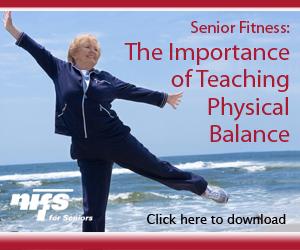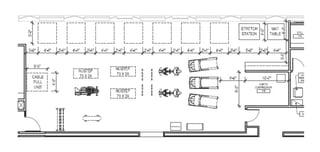Many communities offer balance training to their residents simply as a component of a group fitness class on the activities schedule. I’m here to tell you that is not enough! Residents need an opportunity for group classes solely dedicated to balance training, as well as balance assessments, equipment, and workouts in their community fitness centers.
Comprehensive balance training programming is often an early success when NIFS begins staffing a fitness center at retirement communities. We’ve been able to engage many residents in the fitness program who previously wouldn’t buy into other modes of physical activity, but they are chomping at the bit to participate in balance training opportunities that can decrease their risk of falls and improve their confidence. Doing so is sometimes a “gateway activity” to help residents recognize their abilities. After building that initial confidence, they experiment with a NuStep or a chair aerobics class. We’ve all got to start somewhere!
NIFS’ Balance Challenge Program-resized-600.png?width=302&height=142&name=c--users-kgootee-dropbox-bc_(2012right)-resized-600.png)
To promote existing balance training programs at our CCRCs, NIFS will hold its inaugural Balance Challenge in March. The Balance Challenge program encompasses different elements of our regularly offered balance training programs and services as well as a few new opportunities for residents. Participants will track their activity on a scorecard and will be required to participate in group classes, educational lectures, assessments, fitness center workouts, obstacle courses, and much more to complete the Challenge. The program is designed with activity options for residents of varying ability levels so it can be marketed to someone new to the fitness program looking to get into a routine, or for seasoned participants to further hone their skills.
All participants in the Challenge will complete a Fullerton Advanced Balance Scale test as well as a pre- and post-program survey in which they will rate their current balance skills and confidence levels. In future programs, we hope to see that our participants are maintaining or improving their balance abilities as well as their confidence levels through engaging in not only the month-long Challenge, but also throughout the year in regularly scheduled programs. (Consider the marketing advantages for a community with data of this nature to back up the effectiveness of your balance programs!)
Things to Consider When Starting a CCRC Balance Program
Here are a few key considerations when launching a comprehensive balance program for your residents:
- Who is qualified to lead these types of classes and services for your residents?
- How will you track the impact the program is having on your residents’ functional abilities and how will you utilize that information?
- How can you utilize resident volunteers to act as your balance champions to demonstrate exercises, provide testimonials, etc., on the effectiveness of the program? (Residents seeing their peers demonstrate exercises may help them get over any fears of participating.)
- How can you partner with your community therapy department in balance program offerings?
Whether your community already has a variety of balance training opportunities, or you are looking to launch some new initiatives, consider how a comprehensive program can help spark enthusiasm in your residents!


 Good posture
Good posture While many residents aren’t burning the midnight oil to ring in the new year on December 31, that doesn’t mean that the spark of renewal and enthusiasm to embrace a new year is any less for these folks. The new year is a great time for senior living communities to launch or promote their community wellness program.
While many residents aren’t burning the midnight oil to ring in the new year on December 31, that doesn’t mean that the spark of renewal and enthusiasm to embrace a new year is any less for these folks. The new year is a great time for senior living communities to launch or promote their community wellness program. among owners and operators of senior living communities toward a focus on resident wellness. The movement is based in
among owners and operators of senior living communities toward a focus on resident wellness. The movement is based in 

 While exercising the brain is of great importance in retirement wellness centers to aid in preventing or reversing memory loss and dementia, it’s never too early to start actively increasing your “brain fitness.” Occasional memory loss happens to anyone, young or old. It often occurs in moments of fatigue, nervousness, or anxiety.
While exercising the brain is of great importance in retirement wellness centers to aid in preventing or reversing memory loss and dementia, it’s never too early to start actively increasing your “brain fitness.” Occasional memory loss happens to anyone, young or old. It often occurs in moments of fatigue, nervousness, or anxiety. Most people would agree that regular exercise is part of a healthy lifestyle, but how much of an impact does physical activity really have on one’s health and well-being?
Most people would agree that regular exercise is part of a healthy lifestyle, but how much of an impact does physical activity really have on one’s health and well-being?
 Balance: simple right? I regularly work with a senior population that tells me, “My balance is lost” or “I don’t have balance.” They are under the impression that you either have balance or you don’t.
Balance: simple right? I regularly work with a senior population that tells me, “My balance is lost” or “I don’t have balance.” They are under the impression that you either have balance or you don’t.